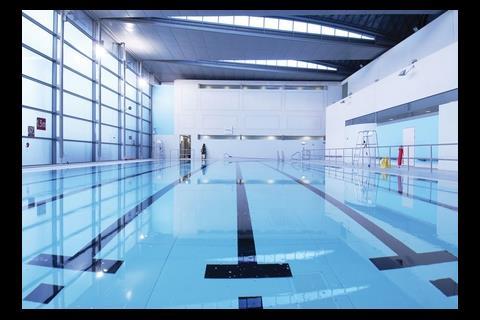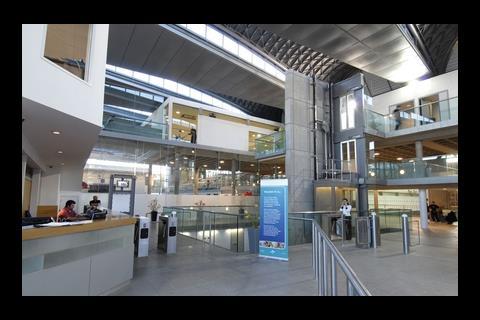In 1996, one of Britain’s hottest young designers was given a £7m leisure centre project in north-east London. Over the next 11 years, it mutated into a £45m disaster that cost him his London office, his marriage and £250,000 of his own money.
As the Clissold centre finally reopens, Stephen Hodder tells Mark Leftly his side of the story for the first time.
Next week one of the great sagas of recent architectural history will finally, hopefully, possibly come to an end. It’s hard to believe that a swimming pool in the impoverished east London borough of Hackney could earn such a reputation, but the Clissold leisure centre, which will re-open to the public on 15 December, has known only problems: at £45m, it will cost seven-and-a-half times its original budget; it is more than eight years late, having already opened once only to close 22 months later over health and safety fears; and the council ended up taking legal action against the architect, QS, consulting engineer and contractor.
The man who has arguably suffered most is Stephen Hodder, Clissold’s architect. Not only did his reputation in the capital take a battering, but the project took £250,000 from his pocket, exposed him to extraordinary personal abuse, and was a contributory factor to the closure of his London office and his divorce from his first wife. It is hardly surprising that, until now, it is a subject he has chosen not to talk about publicly.
The poisoned chalice
By the mid-nineties, Hodder had left Building Design Partnership, started a swashbuckling practice in Manchester and was on the verge of great things. In 1996 his Centenary Building, a faculty for 400 students at the University of Salford, was the first winner of the Stirling prize.
Hodder invited to the ceremony two councillors from the London borough of Hackney, which had just asked him to design a £7m leisure centre for Stoke Newington.
The area needed help, and Hodder’s design, with its gleaming aluminium roof, was clearly the type of building to raise its reputation. The idea was to partly fund it out of lottery coffers and open it in 1999, in time to celebrate the new millennium.
Hodder soon encountered the sort of problems that go with local government work. “In the early days, there was a constant change of personnel at the council,” he recalls. “Tony Ellison, the chief executive, left, the [in-house] project manager changed. There was a tremendous lack of continuity.”
Kim Wright, director of community and leisure at Hackney, admits: “It’s no secret. There was no overall political control and it was a fairly chaotic managerial arrangement.”
But the real difficulties started in 1997 when Sport England, one of the scheme’s co-funders, designated Hackney a priority initiative area, which meant, according to Hodder, that there was money available to take the budget to £10m. However, what should have been a boon for the project quickly became a poisoned chalice.
“That prompted Hackney, not unreasonably, to rethink the brief,” says Hodder. “I felt there were things that we could improve … the size of the gym facility could be bigger, there was no spectators’ facility. There was quite a lot of public consultation that led to changes – for example, to the changing rooms because of the Orthodox Jewish community.”
There was debate, too, over the scheme’s two 25m swimming pools. Some felt that there should be a single 50m Olympic pool – an idea that was dropped – but one of the pools was stretched from six to eight lanes.
These were substantial changes, but Hackney was keen to start work on site as soon as possible, partly because it had been advised that this would save on VAT. However, tenders for the project came in at £13m, £3m higher than anticipated. The design team and the council came up with a compromise budget of £11.5m, but in the meantime Gleeson, the contractor, was being pushed to get started.
Wright, the council director, questions parts of this version of events, saying that the budget rose to £21m as a result of Sport England’s money. She adds: “That’s the first I’ve heard that VAT had anything to do with the start date.”
In any case, costs were clearly mounting. Hodder simplified the construction layers that made up the roof and changed the curtain walling, but when these changes were retendered, the expected cost savings did not arrive. Hodder says: “It was a client decision to start, although they were compelled to do so because of the VAT thing. Then we started on site without the £1.5m in savings being market tested. The savings weren’t real.”
By now, Hodder had opened his London office, just off Great Portland Street in the West End. At its peak, it had six people working on Clissold, out of a staff of 21 roughly split between Manchester and London. Hodder was in London two or three days a week.
The pressure on the London office was enormous. Construction was “sometimes at a standstill”, Hodder admits, as the design team had to look again at parts of the project in order to meet the cost plan. Hodder’s own growing reputation raised expectations further: “During the building process there was a level of public expectation and within the architectural community, too, following what we had achieved in 1996,” he says. “There was a lot of positive press. The project was slipping behind programme, but a lot of that wasn’t reported.”
This, Hodder adds, is one of the key lessons that he’s taken from Clissold: “I should have been stronger, instead of telling people what they wanted to hear, and stopped the project for three or four months and done market testing. I should have taken a more robust line. Now I’ll say if I’m concerned about whether I can deliver a project.”
‘Working for nothing’
The centre finally opened three years late in February 2002 at a cost of £32m – or £35m at 2007 prices. The building had been completed in 2001, but fit-out problems further delayed the project. Wright says: “The cost went up a further £10m because of design changes, cost control problems, and inflation.”
I should have been stronger, instead of telling people what they wanted to hear
Stephen Hodder
By now it was clear that the council would seek damages. Hackney’s project manager had made progress reports to the client every month when the project was on site, and Hodder had not seen them. He was nervous that he had not contributed to the reports and about what they said. Hodder also admits that a scheme could not be that late without the client considering “some form of redress”.
Still, when he saw that people seemed to be enjoying the building, he was hopeful that a dispute could be avoided. And besides, Hodder was convinced of his own professionalism: “I’d agreed a lump sum fee, so I was paying for salaries and overheads during the delay. I lost over a quarter of a million quid. For 18 months I was working for nothing.”
Hodder’s hopes were dashed. A legal claim was lodged against his company and cost consultant Davis Langdon for £7m. By late 2004, the council had also sued Whitbybird, the consulting engineer, and contractor Gleeson. The legal actions were all settled out of court by 2005. “We got a substantial amount,” says Wright. “But we’re bound by a confidentiality clause not to reveal the sum.”
A source close to the actions adds: “At one stage everyone was getting pulled in this direction and that. It was agreed that nobody should say anything to anybody, so badly was everybody slagging each other off in the press.”
And Hodder suffered worse than most. One February evening in 2004 on a train home he opened the London Evening Standard to find that the Clissold centre had been accused by one critic as a “monument to architectural arrogance”, while Jules Pipe, the Hackney mayor whom Hodder had not met because he had only been elected at the end of 2002, argued that he was “determined to make sure that whoever was legally and financially responsible for this is held legally and financially responsible”.
Although Hodder was still on shortlists for sports facilities outside of the capital, the criticisms still hurt: “I thought to myself: ‘This is not about architecture and design; how did it get so personal?’”
The criticisms were not confined to the mainstream media. A group of residents set up the “NOT THE Clissold Leisure Centre” website, which included a “Hod watch” section. Always antagonistic, the nadir came last year when it doctored a picture of Hodder receiving an honorary degree from Manchester Metropolitan University, turning him into Baldrick from the Blackadder television series.
“I think that when the website started it had a genuine concern that theirs was a voice that hadn’t been listened to,” says Hodder. Of the Baldrick transformation, he adds: “It’s just so childish, you have to rise above it.”
Still, the stress took its toll during the intervening years. In 2002 Hodder shut the London office when two of the associates running the Clissold project left to set up their own practice. The office had really only focused on Clissold, and a PFI civic centre, also for Hackney. Hodder toyed with using the London office to run a commission for Oxford University’s St Catherine’s College, but decided that putting his most important client in the hands of new staff was too risky.
Worse was to come. At the end of 2002 he split from his wife. He says: “Clissold was a contributory factor [to the divorce]. You had the stress and anxiety caused by the project – I was living almost a double life in London and the North-west. Life moves on and I met somebody I should have met a long time ago and we have two kids.”
The centre itself continued to suffer while the disputes dragged on. In 2003 a flood forced the centre to close. A statement from the council said: “Due to poor weather and structural leaks it has become necessary to close the entire centre for one week while damage is assessed.” It did not open for four years.
The four-year wait
It is understood that valves were opened in the teaching pool, allowing water to hit the electrical system, and a tear in the vapour barrier of the roof caused condensation. Bickerdike Allen, a practice that specialises in forensic architecture, investigated the problems but was not appointed to resolve them for a year. This delay arguably worsened the situation, and Hodder says water leaking from the showers eventually ran on to the timber floor of the sports hall.
By this stage, Hodder was no longer involved: he last visited the building several years ago, accompanied by his lawyers.
Wright says the flood pushed the council into a root-and-branch refurbishment of Clissold. “It was beset by problems even during the 18 months it was open. There was no waterproof membrane, the showers were leaking into the plant room, and there was internal rain. The flooding in the basement was so severe that it would rise up to the power systems. We went in for forensic analysis and it was soon apparent that there was no quick fix.”
Indeed, the fix has taken nearly 50 months, and raised the price tag to £45m, compared with £35m (at today’s prices) when it opened.
Now, Hodder’s vision is finally complete – well, almost. As it turns out, the building will still not be fully open after the end of next week. A spokesperson for Hackney confirmed that the cafe will not be serving until next month. For Hodder, though, there is a chance that the focus will return to the architectural quality of the building itself. “There were a lot of ideas and invention I was exploring at Clissold. The wall cladding to the sports hall was inspired by a lecture I gave in Tokyo, at the Architectural Institute of Japan. The lecture hall had gold timber acoustic cladding and we re-interpreted it.”
He sums up: “I would like to say that I am so pleased that the centre has been built and people can now hopefully enjoy it. It’s been so unfortunate, and on behalf of the client and the design team I’m so very sorry that it came about.”
And, just maybe, Hackney residents will see him donning a pair of Speedos sometime in the near future: “I’d like to visit it. In my architectural life, it’s been a big part of me.”
The project in numbers
£7M the initial project cost in 1996
£13m original tenders for the project in 1997
£11.5m the cost of the revised plans for the centre
£32m the cost of the centre when it opened in 2002
£45m the cost of the centre when it reopens this month
Postscript
For the whole story of the Clissold centre, search www.building.co.uk/archive































1 Readers' comment